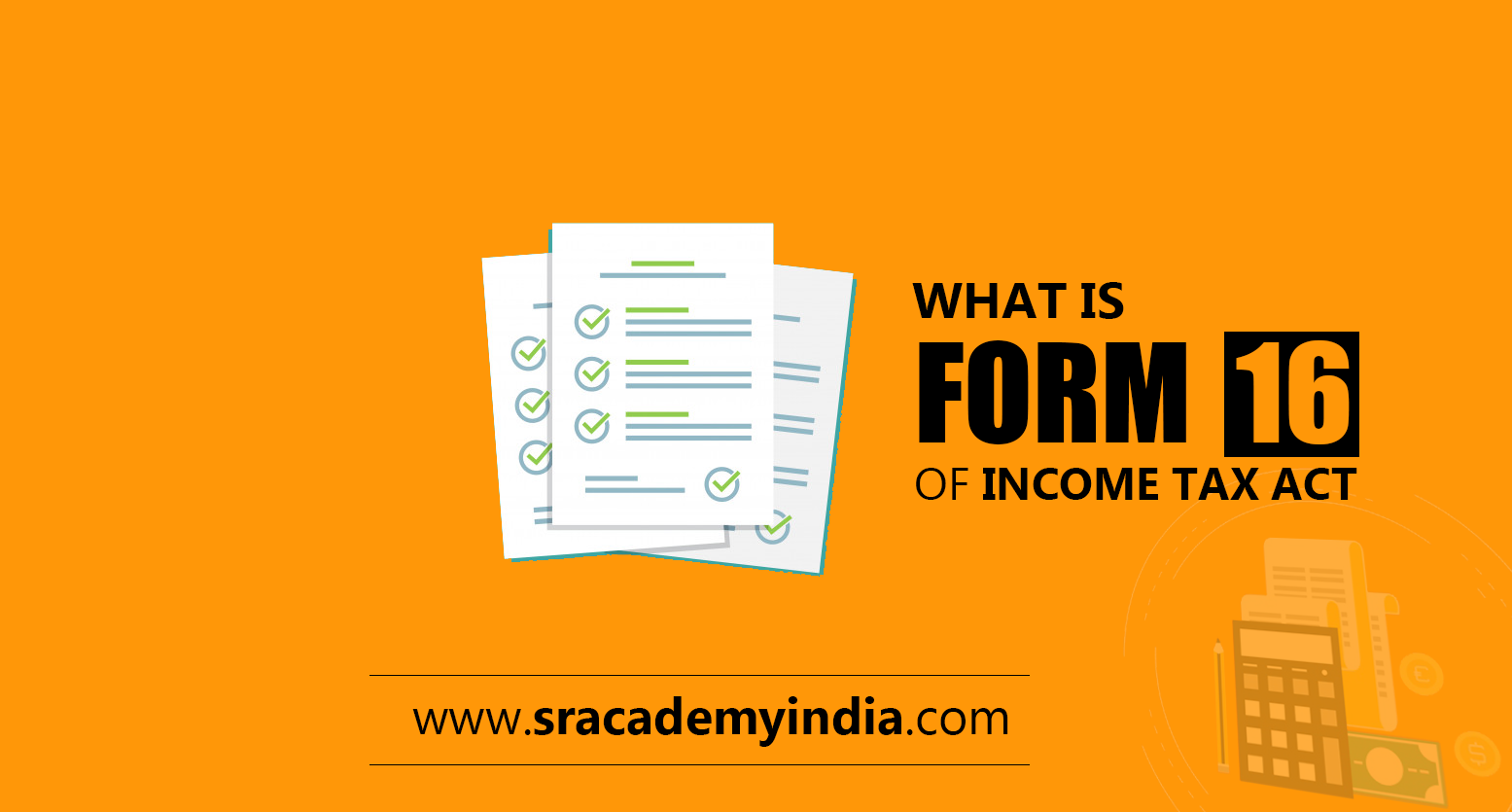Form 16 of Income Tax is a certificate provided by the employer to the employee in respect of the income tax deducted on the salary income of the employee. Form 16 is basically divided into two parts i.e. Part A & Part B.
Let’s understand in detail about the Form 16 of Income Tax.
Introduction
Every financial year, employer will calculate income tax liability of the employees based on their estimated income and accordingly tax will be deducted by the employer at each time when salary payment is made. As per sec 192 of the income tax act, income tax has to be deducted at source if the estimated salary income including the value of perquisites during a financial year exceeds the basic exemption limit (i.e. Rs. 2,50,000 or Rs. 3,00,000 or Rs. 5,00,000 as the case may be depending on the age of the employee).
Accordingly for those employees who are covered under TDS mechanism, employer will calculate the income tax, deducts it and remits the same to the credit of the Central Government. At the end of the each financial year, generally employer will issue a certificate (which we call it as Form 16) to the employee which contains all the details of salary income, tax paid and other basic details relating to the employee and employer.
Generally at the beginning of the every financial year, employer requests their employees (whoever is coming under the tax purview) to furnish the declaration of their proposed savings in the upcoming year. Based on the declaration submitted by the employees, employer will arrive at the average tax liability and deducts the income tax across the year from the salary payable to the employees.
Contents in Form 16 of Income Tax
Form 16 consists of two parts Part A & Part B.
Part A – Form 16 of Income Tax
Part A contains the general details of the employer and employee which includes:
- Name and address of the employer
- Name and address of the employee
- PAN and TAN of the employer
- PAN or Aadhar of the employee (check whether aadhar is also accepted instead of PAN)
- Period to which it is related (i.e. Assessment Year and the period served with the employer)
- Receipt numbers of Quarterly statement of TDS along with summary of the salary paid and TDS deducted
- Details of Book Identification Number’s (BIN) where tax is deposited without production of challan by any Govt office (For deductors other than Government this section is NOT applicable)
- Tax remittance break-up along with the details of Challan Identification Number’s (CIN) (i.e. BSR code of the branch in which tax is remitted, Date of deposit and Challan Serial Number)
Part B – Form 16 of Income Tax
Part B consists of break-up of salary income, deductions & tax computation as follows:
- Details of Exempted allowances under section 10
2. Deductions under Section 16
3. Income chargeable under Salary head
4. Income (or admissible loss) from house property reported by employee
5. Income under the head Other Sources
6. Breakup of Chapter VI-A Deductions
7. Total Taxable income
8. Tax Payable (including surcharge and Health & Education Cess)
Who will issue Form 16?
Employer will issue Form 16 to the employee in respect of the tax deducted on the salary income.
Procedure for issuing Form 16
All deductors (including Government deductors who deposits the tax through book entry) shall issue Part A & B of Form 16 after generating it from TRACES portal. The same has to be duly authenticated and verified by the employer before issuing to the concerned employee. Part A of the each Form 16 shall have a unique TDS certificate number.
If employee changes the job in the middle of the year, then each employer shall issue separate Part A of Form 16 for the respective period served. However in case of Part B of Form 16, it is the discretion of the employee, either to take Part B from both the employers or only from the last employer.
Why Form 16 is important?
Form 16 gives you the details of salary paid and tax deducted by the employer in a particular financial year. In addition, it gives you all the basic details required for filing your income tax return (ITR).
Form 16 is an important document in cross verification of tax deducted with Form 26AS.
It may be noted that under the new TDS procedure, TAN of deductee/ PAN or Aadhaar number, as the case may be of the deductee and receipt number of TDS statement filed by the deductor act as unique identifier for granting online credit of TDS to the deductee. Hence due care should be taken in filling these particulars. Due care should also be taken in indicating correct CIN/ BIN in TDS statement.
Due date for furnishing Form 16
As per the Rule 31 of Income Tax Rules, Form 16 shall be furnished to the employees by 15th June after the end of the financial year in which salary was paid and tax was deducted. The same is applicable even for the banks while making pension payments.
Accordingly, due date for issuing Form 16 by the employer for FY 2019-20 is 15th June, 2020. However, the same is extended to 15th August, 2020 vide CBDT notification no. 35/2020 dated 24.6.2020.
What is to be verified in Form 16
Upon receiving the Form 16 from the employer, verify all the information contained therein the certificate. Because any mistake in Form 16 may render you ineligible to take tax credit completely. Generally employees will get the tax credit based on the TDS returns furnished by the employer. If employer furnishes the wrong particulars of the employee, recipient might not get the tax credit properly. Hence it is always advisable to cross check with your Form 26AS.
In case of any such discrepancy, approach your employer with the suggested changes so that the same can be amended suitably by the employer by filing the revision statement.
Employer Responsibilities
Employer has to ensure that all the particulars mentioned in Form 16 of the employees are correct and each page of the certificate has to be duly signed and stamped by the competent authority. Completed Form 16 in all respects has to be issued within the due date specified.
Penalty for default
If the DDO fails to issue these certificates to the person concerned, as required by section 203, he will be liable to pay, by way of penalty, under section 272A(2)(g), a sum which shall be Rs.100/- for every day during which the failure continues.
It is, however, clarified that there is no obligation to issue the TDS certificate in case tax at source is not deductible/deducted by virtue of claims of exemptions and deductions.
Form 16 vs Form 26AS
Form 26AS will combine all the tax deducted from your salary and/or non-salary income and deposited with the authorities concerned. Details of tax refund, if any, received during the financial year will also be available in this form. So, tax deductions that are shown in Form 16 / Form 16 A can be cross-checked and verified using Form 26AS. Ideally, the TDS amounts reflected in Form 26AS and Form 16/16A should always match. If there are discrepancies, the Income Tax Department considers the TDS figures as per the Form 26AS only.





